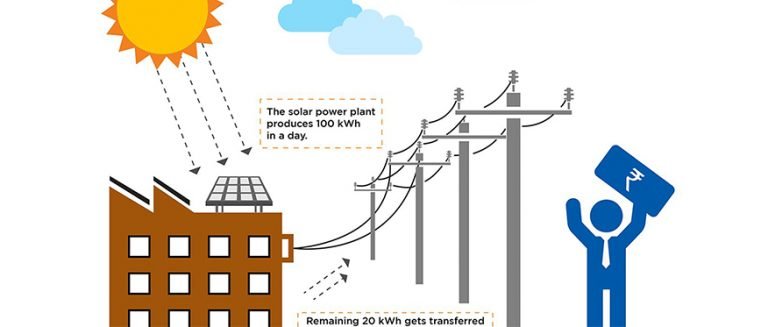The concept of Net Metering explained

We live in an age where people across the world are becoming increasingly conscious of the environment. Governments are urging and incentivizing companies and citizens to embrace renewable sources of energy. As more and more people are deciding to go green, there are a few terms that have crept into our lexicon. One of them is Net Metering.
What is Net Metering?
Net Metering is a system that gives solar energy owners credits for the power that they add to the grid. When solar panels produce excess power, that power is sent to the grid. And this power can be ‘taken back’ when the solar plants are not functioning – example, during the night. When a unit of solar energy that has been ‘net metered’, the bi-directional electricity meter will run backwards. Customers are billed only for the ‘net’ energy use.
Giving Customers Control Over Their Electricity Bills
What Net Metering does is that it gives customers an opportunity to generate clean and efficient electricity. During sunlight hours, most solar customers produce more than they can consume – this surplus is exported to the grid reducing electricity bills.
Adding Value to Society and Boosting Private Investment
- Value addition to DISCOMs: One of the biggest advantages of Net Metering is that it helps trim peak load demand during the day and reduces load shedding. Further it helps State DISCOMS reduce their T&C wheeling losses.
- Value addition to end-users:Net Metering helps corporates, industrial establishments and educational research institutes save money on electricity bills. The money saved can be invested into in their existing business or can be used to improve educational infrastructure in universities and schools.
Saves on Expensive Batteries
In Net Metering, the grid acts as a huge ‘bank’ and ‘stores’ your extra solar power for times when you don’t have enough. This eliminates the need for an expensive battery bank. A small battery backup system should be sufficient for power outages.
No Maintenance
The major components you need for a grid-tied net metering system are solar modules, that produce power and an inverter that converts the DC power from the solar panels to the standard AC power produced by the utility. Both these components require little maintenance because there are no moving parts. Modules have a long warranty and are manufactured from a semiconductor material that is usually protected by a tempered glass front.
Data Capture
Net metering records the energy generated and sent to the grid and consumed from the grid, providing vital data. Your electricity bill is the net difference of the two, accounting for any time of use plans you might select and other charges.
Greener World
As solar energy systems are connected to the state’s distribution system, the demand for electricity generated by traditional methods will reduce – thus preserving the environment.
Rooftop solar and net metering
“Many industries have lots of idle space on roofs which can be used for solar plants. But very few do so because of several issues, one of them being unfriendly net-metering rules,” believes Mr. Parv Arora, Managing Director, Resol. Unless net-metering rules are rationalized, there is little scope for rooftop solar development.
Resol has helped more than 60 large corporates in India in their solar journey. It is the largest rooftop solar provider in India.
Challenges and the way ahead
While many states in India have created net metering policies, the implementation has almost been universally slow and there are arbitrary constraints and limits. Tamil Nadu does not allow net-metering for HT power consumers i.e large off-takers of power and in most states, there is a cap on the size of the solar plant that can be availed under net metering.
“Rooftop solar sector has not really taken off mainly due to the poor implementation of net metering policy,” says Mr Parv Arora, Managing Director, Resol. He adds that net metering policies in most states are not being implemented and there is a lack of follow-through.
The Way Ahead
While a greener environment is the overall benefit of solar energy, introducing progressive net-metering policies will make the sector grow exponentially. The union government must come up with better ways to implement the policy framework on net-metering so that 40 GW solar target can be reached by 2022.
